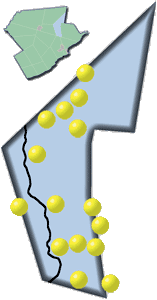|
About Price Township
Overview
Price Township is located in Monroe County of Pennsylvania, right in the farther eastern region of the state. Although a township on its own, it's actually considered the smallest in its region, particularly when compared to other nearby Monroe County townships. The township extends around 7 square miles from the north-south and five miles to the east-west borders.
Unlike other townships, Price Township didn't start with an incorporated village and/or town within its own borders. Instead, the township remained relatively uninhabitable until settlers started building and establishing key necessities throughout the township itself.
Price Township Today
Today, Price Township is a relatively modest township that houses over 3,500 residents (as of 2010). Much like surrounding townships in Monroe County, it's a natural home to many Pocono homes in the current Pocono real estate for current and prospective residents to see.
History
Price Township was first established and subdivided out of Smithfield Township in 1830. Its name came from the first European settler in the area, John Price. He first traveled northward from Bucks County, later settling on a piece of land that initially overlapped Price and Barrett Townships. Many of the first settlers settled at the rich land located along Brodhead Creek.
As mentioned, the township didn't establish an incorporated village or town within its borders. There were few existing roads during the time; the roads that did exist were in 'very poor condition.' The streams and rivers didn't have any bridges to help settlers cross them and the water always required some type of fording.
The oldest road, however, dates before the late 1700s. It joined Wayne County's Stroudsburg and Newfoundland. This roadway eventually traveled through the Brodhead Creek, continuing through Price Township. This historic route is now a part of Route 447 today.
The rich land in Price Township helped fostered several industries. The predominant industry was lumbering at the time, since saw mills were built to accommodate the abundance of lumber used in various applications. Residents who didn't work in the lumber industry found work as farmers.
The first schoolhouse arrived in 1810. By the later portion of the century, three schools served around 50 students in the area.
1867 bought the establishment of a church known as the McComas Chapel, named after the church's first minister, the Rev. N.D. McComas. Its accompanying cemetery is also known as the only burial ground located within the township, known to be much older than the church itself.
| 

